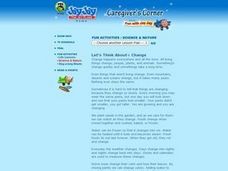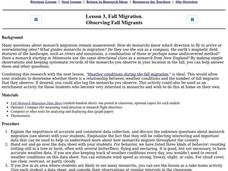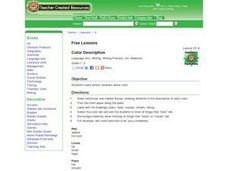Curated OER
Optional Laboratory: Soil Particle Size and Texture
Students work together to perform experiments on different types of soil. They record the soil's pH level, color and texture. They develop hypothesis' on what they believe they will discover before beginning the experiment.
Curated OER
Fire Wars
Students identify fire risk factors for a property located near a wildland area. Students discuss ecosystems subject to wildland fire and consider what could be done to eliminate the problem.
Curated OER
Pollen Collection And Identification
Pupils investigate plant reproduction, pollen collection and identification. They collect pollen samples over a twenty four hour period and examine them under a microscope.
Curated OER
Plants
Second graders examine the characteristics of plants. As a class, they brainstorm a list of items plants need in order to survive. In groups, they complete various experiments in which they discover the functions of the parts of the plant.
Curated OER
Habitats: Rainforest
Students use the internet to find reasons the rainforest is endangered and ways that affects the rest of the world. They read for information, perform experiments, locate rainforests on maps, and write about this ecosystem.
Curated OER
The Case of the Mysterious Red Light
Students investigate why some sunrises and sunsets are unusually bright red.
Curated OER
Birds of A Feather
Young scholars observe and record the many types of birds they see in a month. They discover the many patterns birds follow and compare their results with other classrooms. They complete a field assessment as the final activity for this...
Curated OER
Rocky Observations
Students examine two images of rocks, make their own observations of individual rocks through drawing, and explain how the same observation skills can be used in the study of geology.
Curated OER
Fair Trade: Chocolate Can Be Good For You
Students discover the process of chocolate production. They read stories from boys in Ghana and Brazil who work on cocoa plantations. They illustrate the principles of fair trade.
Curated OER
Acid Rain Keeps Falling on My Head
Students examine the pH level of rain water in their local community. They locate each location on a map. They analyze the data and draw conclusions.
Curated OER
Let's Think About... Change
Students observe various examples of "change." They mix paint to cereate new colors, eat bread and then toasted bread, and match baby pictures with pictures of how the same people look in the present. Finally, they watch a bouquet of...
Curated OER
Observing Fall Migrants
Students keep a detailed data collection log of the different types of monarch behavior. They track the weather conditions daily and link it to the migration of the monarchs. They summarize their data using either a graph or a computer...
Curated OER
No magic borders
Middle schoolers discuss what they have heard about pollution. They explore the purposes and limitations of political boundaries and borders and identify some of the causes and effects of pollution.
Curated OER
Nebraska: Using Pictures
Students create a scrapbook about Nebraska history focusing on Post Office murals. They choose their favorite murals and write a story to go along with the mural. In groups, students present their murals to the class and visit the...
Curated OER
Antlion Pit Building Investigation
Students design and perform an experiment related to comparing and contrasting antlion pits. Given a set of parameters, students select a hypothesis and perform observations on antlion pits. They record data and use this date to support...
Curated OER
Recycling Garden Waste
Students experience how to make compost. This instructional activity is ongoing with periodic checks and maintenance. They select a piece of ground around the school or around their homes to establish a compost pile. Organic materials...
Curated OER
Safety
Students investigate the concept of voltage and electricity. They differentiate between an insulator and a conductor in the context of using electrical safety with the help of a doll house. Then students pretend the doll lives in a real...
Curated OER
Living in the Oak Woodlands: Early People of the Jewett Mine Area
Students are introduced to the early peoples living in the Jewett Mine area. After viewing transparencies, they view pictures of the mine today and its main area of production. For each picture, they develop symbols and captions about...
Curated OER
Color Description
Learners explore the use of description in literature and color. They read Hailstones and Halibut Bones and discuss the description of each color. Students what each color makes them think of and they create pictures for each color.
Illustrative Mathematics
Illustrative Mathematics: G Mg How Many Leaves on a Tree? (Version 2)
In this task, learners must estimate the number of leaves on a large tree, taking into account various complex factors such as the area shaded by the tree, the area of irregularly shaped leaves, the uneven distribution of leaves, the...
Illustrative Mathematics
Illustrative Mathematics: G Mg How Many Leaves on a Tree?
This is a mathematical modeling task aimed at making a reasonable estimate for something which is too large to count accurately, the number of leaves on a tree, taking into account the tree size and the density of the leaves. Aligns with...
University Corporation for Atmospheric Research
Ucar: Modeling Tree Transpiration
In this activity, young scholars will observe and measure the water given off through transpiration by a plant in a small terrarium.
University of Maryland
Maryland Sea Grant: Dendroclimatology
This is a set of lessons where students investigate tree rings and what scientists can learn from them. They measure tree rings and correlate the data to precipitation patterns in order to make predictions about the climate. For an...
Alabama Learning Exchange
Alex: Is It Really That Big?
Just how tall is that object? In this lesson, students will participate in an outdoor group activity using shadows to extend their knowledge of proportions to solve problems dealing with similarity. The cooperative learning groups will...





















